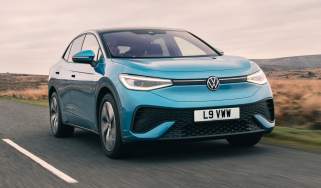Volkswagen ID.4 review - Electric motor, drive & performance
"It might be heavy, but the ID.4 handles surprisingly well"
It may come as a surprise but the ID.4 is rather good to drive. The car’s driving dynamics are helped by the low centre of gravity of its battery, and the rear-wheel drive version we tested has an ideal weight distribution between the front and rear. This helps to offset the fact top versions of the ID.4 are heavier than the Hyundai Ioniq 5 and Toyota bZ4X, with the Volkswagen weighing over 2.2 tonnes.
Clever design helps it to handle respectably well, with impressive body control and driving manners. The suspension is supple enough to soak up most imperfections but doesn't allow the body to roll around too much on a challenging stretch of road. The steering is also a good weight and precise, so you quickly feel confident behind the wheel. There are other benefits to the lack of an engine up front, including a sharp turning circle of just 10.2 metres. Thanks to the front wheels being able to turn more acutely with no engine in the way, driving in town and parking manoeuvres are made much easier.
While performance VW's with petrol and diesel engines get the GTI and GTD badges respectively, the marque has now introduced a GTX badge for its fast electric models. This has reached the ID.4 first, and the GTX has upgraded suspension and slightly more aggressive looks compared with the standard car. It doesn’t feel like a GTI, though, instead being just a faster version of the regular ID.4, with little extra excitement on offer.
More reviews
Body lean might be well contained, but the steering feels light and artificial, and even the Toyota bZ4X is more enjoyable to drive. The lack of noise from the electric powertrain does detract slightly from the experience, with the faint hum and slight whistle from the front motor hardly the stuff of enthusiasts’ dreams. Given performance models like the Porsche Taycan and Audi e-tron GT feature immersive artificial engine sounds, we can’t help but feel that VW could have done the same for the GTX to add to the experience.
Volkswagen has stayed away from 'one pedal' driving where the car will brake heavily and even stop if you come off the accelerator, as the brand felt this could be off-putting for drivers who are new to electric vehicles. That's a shame, as we've found it possible to adapt quickly to this style of driving.
Volkswagen ID.4 electric motors
The entry-level version of the Volkswagen ID.4 (called Pure) now gets a 168bhp electric motor powering the rear wheels. That’s enough to propel the ID.4 from 0-62mph in nine seconds – that’s slower than many have come to expect from an EV, but in reality it’s the sort of power most people would be used to in a mainstream conventional petrol or diesel small SUV.
Power takes a big bump up in the model above this, called Pro. This has 262bhp, making it good for a nippier 0-62mph time of 6.5 seconds. There’s a four-wheel drive version that sits above this, called Pro 4Motion, but that only cuts the acceleration time by a tenth of a second. Buyers who want a little more assurance and grip might consider this model, but it won’t be necessary for most.
The GTX is the most powerful of the bunch and gets 335bhp sent to all four wheels. It will sprint from 0-62mph the fastest as a result, taking just 5.4 seconds to do so.
Which Is Best?
Cheapest
- Name125kW Match Pure 52kWh 5dr Auto [19'' Alloys]
- Gearbox typeAuto
- RRP£39,580
Most Economical
- Name250kW 4MOTION GTX Edition 79kWh 5dr Auto
- Gearbox typeAuto
- RRP£52,825
Fastest
- Name250kW 4MOTION GTX Edition 79kWh 5dr Auto
- Gearbox typeAuto
- RRP£52,825












